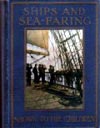|
| To Search This Site Enter Key Words Into Text Field On The Right and Hit The Search Button |
|
|
A Brief History of Dust Jackets.
Dust jackets on books are so ubiquitous, that most people never give them a second thought. But think about it for a minute. How did they come about, and why? When did they first start to be used? Why are they so rarely found on older books? The history of the dust jacket is a rich and complex art form that developed over many generations. This brief introduction of that history will hopefully help to answer some of the more common questions people have asked.
Dust jackets for books were originally known as dust wrappers. They literally wrapped the book, protecting it until you got it home. At that point the wrapper was to be discarded, having served its purpose. Mostly the wrapper was just that, a plain brown paper wrapper. The first known dust wrappers date from 1832, but they did not come into fairly common use until the late 1800s.
By the 1890’s, dust jackets began to be found in a form very similar to that we know today, although much plainer. Mostly they were of a heavier stock of paper, and they were typically blank except for the title on the spine of the jacket. It was shortly after the turn of the century that someone had the bright idea to put the blank space on the wrapper to some use by placing advertisements there. That began the long road to the slick commercial dust jackets of today.
The dust jacket (left) and book cover (right)
for the 1895 edition of William Dean Howells
novel Their Wedding Journey.
 |
 |
The concept of the dust jacket being there only to protect the book till you got home, then discarded, lasted in people's minds at least through the 1940’s & 50’s. That is why so many of the books in our parents or grandparents libraries do not have their dust jackets. They threw them out as soon as they got the book home. Ancillary to this was that during this same time period, people still remembered libraries full of beautiful leatherbound books from the days of their own parents. Paper dust jackets looked very tacky by comparison. But by getting rid of them, and showing the spines of the books instead, it gave a library more of that look of an expensive leatherbound collection.
The other significant factor contributing to the scarcity of early dust jackets is their fragile nature. The pre-1900 jackets were typically made of a thicker paper, almost like linen or oilskin, but starting after the turn of the century, the paper for jackets became thinner and much more flimsy. These latter style jackets were easily damaged, torn, etc. Many old dust jackets have not survived simply because they were not well cared for. Modern collectors can avoid this by having their dust jackets protected with an archival quality, acid free, clear acetate cover to protect them.
In the high-end book collecting market, it is expected that any book from 1920 on will have its dust jacket intact. Before 1920, a copy with the dust jacket is to be considered the exception rather than the rule, even though it is assumed that from the turn of the century on, most books would have had a dust jacket.
For the average collector though, the practical reality of the market is that 1940 seems to be a much more realistic cutoff date. Books published after 1940 should be expected to have a dust jacket, to be considered to be in collectible condition. Books before 1940 do show up with dust jackets, but not so consistently. Thus books before 1940 with a dust jacket should be considered the exception rather than the rule.
What is the value of dust jackets? Believe it or not, in certain collectible circles, most notably first edition fiction, the dust jacket can represent from 75% to 90% of the value of a book! Again this pertains only to modern first edition fiction. For nonfiction books, the value of the dust jacket is usually worth around 20% to 30% of the value of the book.
Putting this into the context of Titanic books, most of the books published in the 1912 to 1915 range probably did have dust jackets. The exception would be the 'instant' Titanic books published right after the disaster (Logan Marshall's book, Jay Mobray's, Marshall Everett’s etc.) probably never had dust jackets. Most of the other books from this period probably did.
The dust jacket (left) and book cover (right)
for Arthur O. Cooke's Ships and Sea-Faring
Shown to the Children, circa 1917.
 |
 |
Beesley’s and Gracie’s books published in 1912 and 1913 respectively, are pretty much smack in the middle of the grey zone between when dust jackets were first gaining widespread use, but before they really caught on as a tool for selling fiction in the 1920s.
I have never seen a dust jacket for Beesley's or Gracie’s book. As such, I cannot speak with absolute certainty, but I can say that there is a very good probability that both did indeed have dust jackets. I am told that Filson Young’s 1912 Titanic book came with a dust jacket as well.
As you move forward in time from 1912, the more likely it is that books had dust jackets. We know for sure that Elbert Hubbard’s 1923 book definitely had a jacket, for example. It is a pretty safe bet that any book published after 1920 almost certainly came with a dust jacket when it was originally released.
|
|
|
|